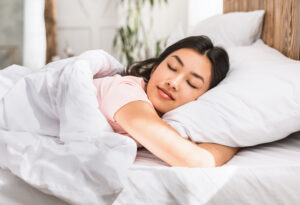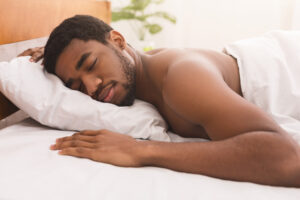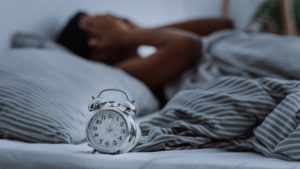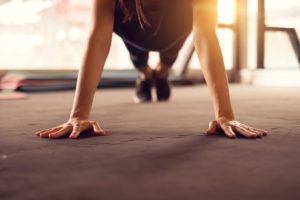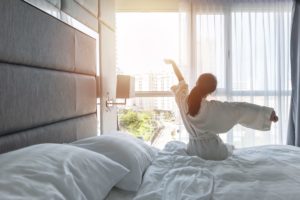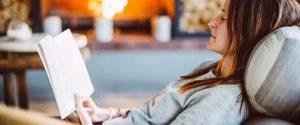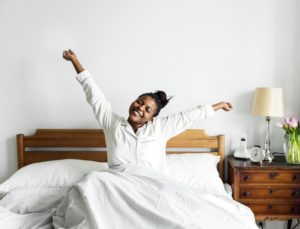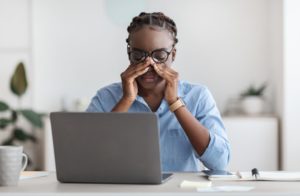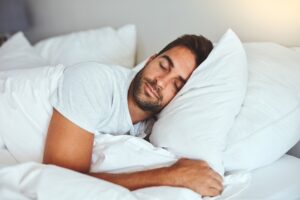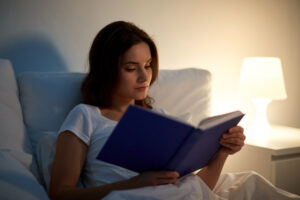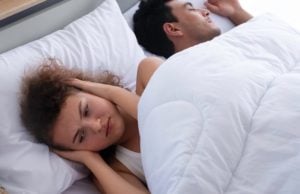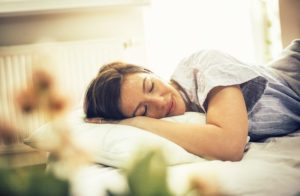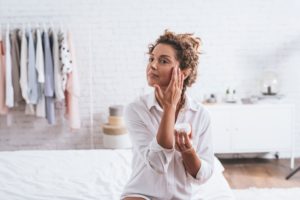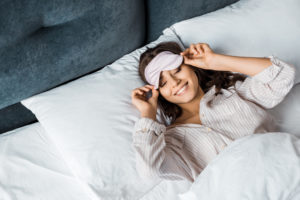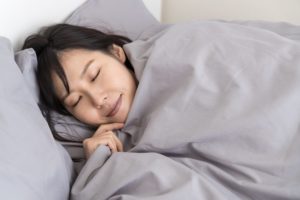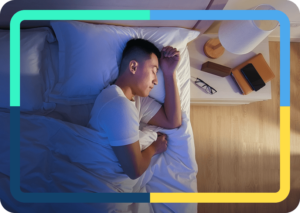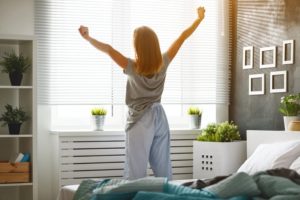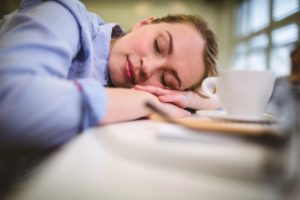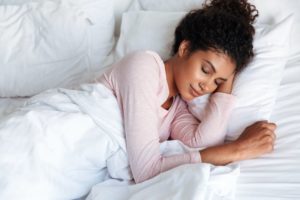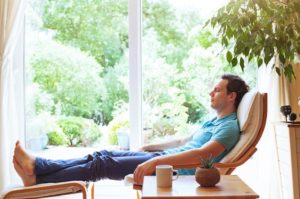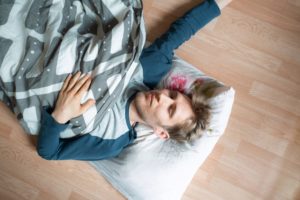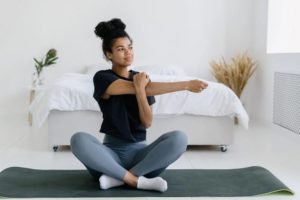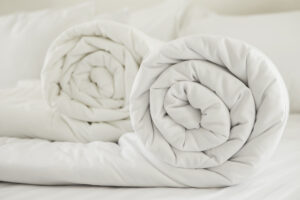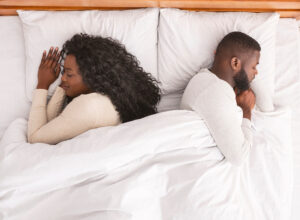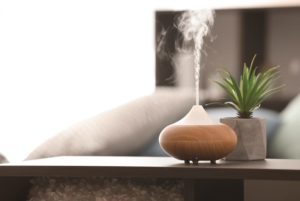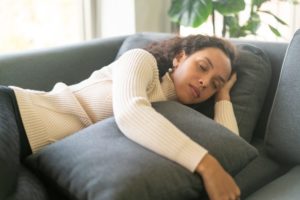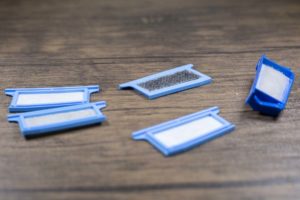When you buy through our links, we may earn a commission. Products or services may be offered by an affiliated entity. Learn more.
Is Sleeping on the Couch a Bad Idea?
Most people have drifted off to sleep on the couch at least once, and some people may choose to regularly sleep on the couch instead of in a bed. While sleeping on the couch appears comfortable at first glance, it may not be the best choice in the long term. We examine whether you can make couch sleeping work for you, or if it is something you should avoid altogether.
Struggling to Stay Awake? Take an At-Home Sleep Test

our partner at sleepdoctor.com
10% off Home Sleep Tests
Buy Now“Truly grateful for this home sleep test. Fair pricing and improved my sleep!”
Dawn G. – Verified Tester
Is It Bad to Sleep on the Couch?
Although sleeping on a mattress is usually the best option, occasionally sleeping on the couch may be appropriate in certain situations. Perhaps the bedroom becomes too hot or too cold at times, while the living room remains a comfortable temperature. Maybe you like to watch TV in the evening, and you doze off before making your way to the bedroom.
You might also opt to sleep on the couch in order to minimize sleep disturbances for your partner or to accommodate out-of-town guests. People with limited mobility may find it easier to stay on the couch rather than make their way to the bedroom, especially if the bedroom is upstairs.
Potential Benefits of Sleeping on the Couch
People in certain situations might benefit from sleeping on a couch instead of a bed.
Easier to Elevate Head
A couch with armrests makes it easier to sleep with your head elevated, which may offer benefits for people experiencing the following health issues:
- Gastroesophageal Reflux Disease (GERD): GERD is a common condition that leads to regular instances of acid reflux and heartburn and often worsens when lying down. Research shows that elevating the head of a bed by 10 inches improves symptoms compared to sleeping flat.
- Obstructive Sleep Apnea (OSA): People with OSA snore and have moments of stopped breathing while asleep, due to the airway becoming obstructed . In a study of people with mild and moderate OSA, sleeping with the head of the bed elevated reduced symptom severity by nearly 32% compared to lying flat.
- Orthostatic Hypotension: Orthostatic hypotension is a condition in which people experience low blood pressure while upright due to autonomic nervous system dysfunction . People with orthostatic hypotension might also experience high blood pressure while lying down. Medical professionals often recommend sleeping with the head of the bed elevated to help improve blood pressure while sleeping, though studies find conflicting results on whether sleeping with an elevated head affects orthostatic hypotension symptoms.
- A Cold or Cough: When you are congested, lying down can cause mucus to travel down the back of your throat, a condition called postnasal drip . Postnasal drip is usually worse when lying on your back, but by propping your head up, you may be able to ease congestion and coughing.
Even though sleeping on a couch may make elevating your head easier, it is important to note that you may be better off purchasing a wedge pillow or bed risers instead of moving from your mattress to the couch.
Potentially Improved Sleep Environment
Couch sleeping might also be beneficial in instances when the couch is in a room that is more conducive to sleep than the bed. The ideal bedroom environment is comfortably cool, dark, and quiet. If sleeping on a couch allows you to avoid disruptive sounds, light, or temperatures, it could promote more restorative sleep. However, sleeping on a couch long-term might come with drawbacks.
Drawbacks of Sleeping on the Couch
People primarily sleep on mattresses instead of couches for a reason. Mattresses are specifically designed for sleeping, which involves lying down for several hours on a nightly basis. Couches are not crafted to offer overnight support for sleepers.
Limited Space
Whether twin size, full size, queen size, or king size, the width of a bed is greater than the depth of the average couch. Switching from a bed to a couch could restrict a sleeper’s ability to roll over or adjust sleeping positions during the night. On average, sleepers shift positions more than once per hour. The smaller sleeping space of a couch might not accommodate these position shifts, potentially resulting in sleep disturbances or discomfort.
The length of most beds also exceeds the width of most couches. For this reason, you might be unable to fully extend your legs while sleeping on a couch. Being forced to sleep in a cramped position might lead to discomfort or pain.
Unsuitable for Infants
Whether with a parent or by themselves, infants should not sleep on sofas, as they present more opportunities to become wedged in a tight place or have airflow blocked off. An analysis of over 1,000 sleep-related infant deaths found that nearly 13% involved a sofa . Infants sleeping on a sofa are 49 to 67 times more likely to experience sudden infant death syndrome (SIDS) than babies sleeping on other surfaces like mattresses.
Experts expressly advise against a parent and baby sleeping together on a sofa because of the associated risk of sudden infant death , which is eight times higher when co-sleeping on a sofa compared to a bed. Even feeding an infant on the couch in the evening poses a risk because parents might accidentally fall asleep.
Back and Neck Pain
Couch sleeping may prompt neck or back pain, especially if you regularly sleep on the couch. Mattresses are purposely designed to support spinal alignment and reduce pain and discomfort from pressure points. Medium firm mattresses , in particular, have been demonstrated to provide balanced support that reduces sleep-related discomfort and lower back pain. Since couches are designed for sitting and not sleeping, they might not adequately support sleepers.
Stomach sleepers may find it virtually impossible to sleep on a couch, as the armrests cause the neck to twist at an excessively sharp angle. Research also suggests that when back sleeping, symmetry is important to prevent neck pain . Specifically, both arms should be in the same position, such as by your sides or on your chest. On a couch, back sleepers might lack the space required to easily keep both arms in the same position. If couch sleeping leads to an asymmetrical sleeping position, it could contribute to neck and shoulder pain.
Side sleeping may be the most comfortable position on a couch. The armrest can act as a high pillow, and a softer couch may prevent pressure points from forming. However, on a short couch, you may need to keep your knees bent, which may cause joint pressure.
How to Get Better Sleep on the Couch
If you are intent on couch sleeping, there may be several ways to promote sound sleep on the sofa.
Consider Investing in a Sleeper Sofa
A sleeper sofa folds out to offer a surface comparable to that of a mattress. This additional space allows you to fully extend your legs and adjust your sleeping position during the night as needed. With a sleeper sofa, you generally sleep on a thin mattress that folds out from within the sofa. With a sofa bed or futon, you sleep directly on connected cushions that fold down to create a flat surface.
Avoid the TV
Sleeping on the couch is particularly problematic if it is accompanied by watching television. Televisions emit blue light , which increases alertness and suppresses melatonin, the sleep hormone. Avoid nighttime blue light exposure and set the stage for better sleep by turning off the TV in the hours before bedtime, even when you find yourself settling down right in front of it.
Block Noise and Light
People often keep couches in common rooms and open areas, like a living room or family room. As a result, you might find yourself dealing with more noise and light disruptions while sleeping on a couch. Eliminating these obstacles to sleep is part of good sleep hygiene, regardless of where you’re sleeping.
Background noise from nearby transportation or people can disturb sleep, negatively affecting your mood and thinking the next day. Consider using earplugs or a white noise machine to block nighttime sounds, whether they originate inside or outside.
Indoor lighting also negatively impacts sleep . When you are exposed to artificial light while sleeping, you are more likely to experience shallower sleep and wake up more often during the night. If couch sleeping makes it difficult to sleep in darkness, invest in a sleep mask to cover your eyes and keep out unwanted light exposure. You can also use blackout curtains to prevent light coming in from the morning sun or a nighttime street light.
Choose the Right Pillows and Bedding
Using comfortable pillows and bedding can help improve comfort regardless of where you sleep.
Certain pillows work better than others to relieve neck and back pain and help you sleep comfortably. The best pillow choice for you depends on your preferred sleep position . For example, side sleepers generally require pillows with a thicker loft to maintain spinal alignment while sleeping.
If you find yourself sleeping often on the couch, it may be helpful to keep sheets and a comforter nearby. Not only can these help keep you and the couch clean, but they also provide a smoother surface than most couches.
Additional Tips for Better Sleep
If you are having trouble sleeping, adopting healthy sleep hygiene practices might help you get back on track. Following certain habits during the day and at night helps prepare your mind for sleep at night. Examples of sleep hygiene habits include:
- Avoiding stimulating activities and excessive exercise at night
- Maintaining a regular sleep schedule
- Avoiding caffeine in the afternoon and evening
- Reducing naps, especially near bedtime
Reserving the bedroom for sleep only helps your brain learn to associate bed with rest, and may help you break the habit of drifting off on the couch.

Still have questions? Ask our community!
Join our Sleep Care Community — a trusted hub of sleep health professionals, product specialists, and people just like you. Whether you need expert sleep advice for your insomnia or you’re searching for the perfect mattress, we’ve got you covered. Get personalized guidance from the experts who know sleep best.
References
16 Sources
-
Ness-Jensen, E., Hveem, K., El-Serag, H., & Lagergren, J. (2016). Lifestyle intervention in gastroesophageal reflux disease. Clinical Gastroenterology and Hepatology: The Official Clinical Practice Journal of the American Gastroenterological Association, 14(2), 175–182.e1–3.
https://pubmed.ncbi.nlm.nih.gov/25956834/ -
Souza, F., Genta, P. R., de Souza Filho, A. J., Wellman, A., & Lorenzi-Filho, G. (2017). The influence of head-of-bed elevation in patients with obstructive sleep apnea. Sleep & breathing = Schlaf & Atmung, 21(4), 815–820.
https://pubmed.ncbi.nlm.nih.gov/28647854/ -
Moroi, M. K., Ruzieh, M., Ahmed, A., Kanjwal, S., & Kanjwal, K. (2021). Prevention and management of supine hypertension in patients with orthostatic hypotension. American Journal of Therapeutics, 28(2), e228–e231.
https://pubmed.ncbi.nlm.nih.gov/31524637/ -
Fan, C. W., Walsh, C., & Cunningham, C. J. (2011). The effect of sleeping with the head of the bed elevated six inches on elderly patients with orthostatic hypotension: An open randomised controlled trial. Age and Ageing, 40(2), 187–192.
https://pubmed.ncbi.nlm.nih.gov/21233091/ -
Singh, D. P., Jamil, R. T., & Mahajan, K. (2021). Nocturnal Cough. In StatPearls. StatPearls Publishing.
https://pubmed.ncbi.nlm.nih.gov/30335306/ -
Skarpsno, E. S., Mork, P. J., Nilsen, T. I. L., & Holtermann, A. (2017). Sleep positions and nocturnal body movements based on free-living accelerometer recordings: Association with demographics, lifestyle, and insomnia symptoms. Nature and Science of Sleep, 9, 267–275.
https://pubmed.ncbi.nlm.nih.gov/29138608/ -
Rechtman, L. R., Colvin, J. D., Blair, P. S., & Moon, R. Y. (2014). Sofas and infant mortality. Pediatrics, 134(5), e1293–e1300.
https://pubmed.ncbi.nlm.nih.gov/25311597/ -
Young, J., & Shipstone, R. (2018). Shared sleeping surfaces and dangerous sleeping environments. In J. R. Duncan, & R. W. Byard (Eds.), SIDS Sudden Infant and Early Childhood Death: The Past, the Present and the Future (Chapter 11).
https://pubmed.ncbi.nlm.nih.gov/30035939/ -
Wong, D. W-C., Wang, Y., Lin, J., Tan, Q., Chen, T. L-W., & Zhang, M. (2019). Sleeping mattress determinants and evaluation: A biomechanical review and critique. PeerJ, 7, e6364.
https://pubmed.ncbi.nlm.nih.gov/30701143/ -
Jacobson, B. H., Boolani, A., Dunklee, G., Shepardson, A., & Acharya, H. (2010). Effect of prescribed sleep surfaces on back pain and sleep quality in patients diagnosed with low back and shoulder pain. Applied Ergonomics, 42(1), 91–97.
https://pubmed.ncbi.nlm.nih.gov/20579971/ -
Lee, W. H., & Ko, M. S. (2017). Effect of sleep posture on neck muscle activity. Journal of Physical Therapy Science, 29(6), 1021–1024.
https://pubmed.ncbi.nlm.nih.gov/28626314/ -
Tosini, G., Ferguson, I., & Tsubota, K. (2016). Effects of blue light on the circadian system and eye physiology. Molecular Vision, 22, 61–72.
https://pubmed.ncbi.nlm.nih.gov/26900325/ -
Halperin, D. (2014). Environmental noise and sleep disturbances: A threat to health? Sleep Science, 7(4), 209–212
https://pubmed.ncbi.nlm.nih.gov/26483931/ -
Cho, J. R., Joo, E. Y., Koo, D. L., & Hong, S. B. (2013). Let there be no light: The effect of bedside light on sleep quality and background electroencephalographic rhythms. Sleep Medicine, 14(12), 1422–1425.
https://pubmed.ncbi.nlm.nih.gov/24210607/ -
Son, J., Jung, S., Song, H., Kim, J., Bang, S., & Bahn, S. (2020). A survey of Koreans on sleep habits and sleeping symptoms relating to pillow comfort and support. International Journal of Environmental Research and Public Health, 17(1), 201.
https://pubmed.ncbi.nlm.nih.gov/31906363/ -
Schwab, R.J. (2020, June). Approach to the patient with a sleep or wakefulness disorder. Merck Manual Professional Version., Retrieved August 15, 2021, from
https://www.msdmanuals.com/professional/neurologic-disorders/sleep-and-wakefulness-disorders/approach-to-the-patient-with-a-sleep-or-wakefulness-disorder




